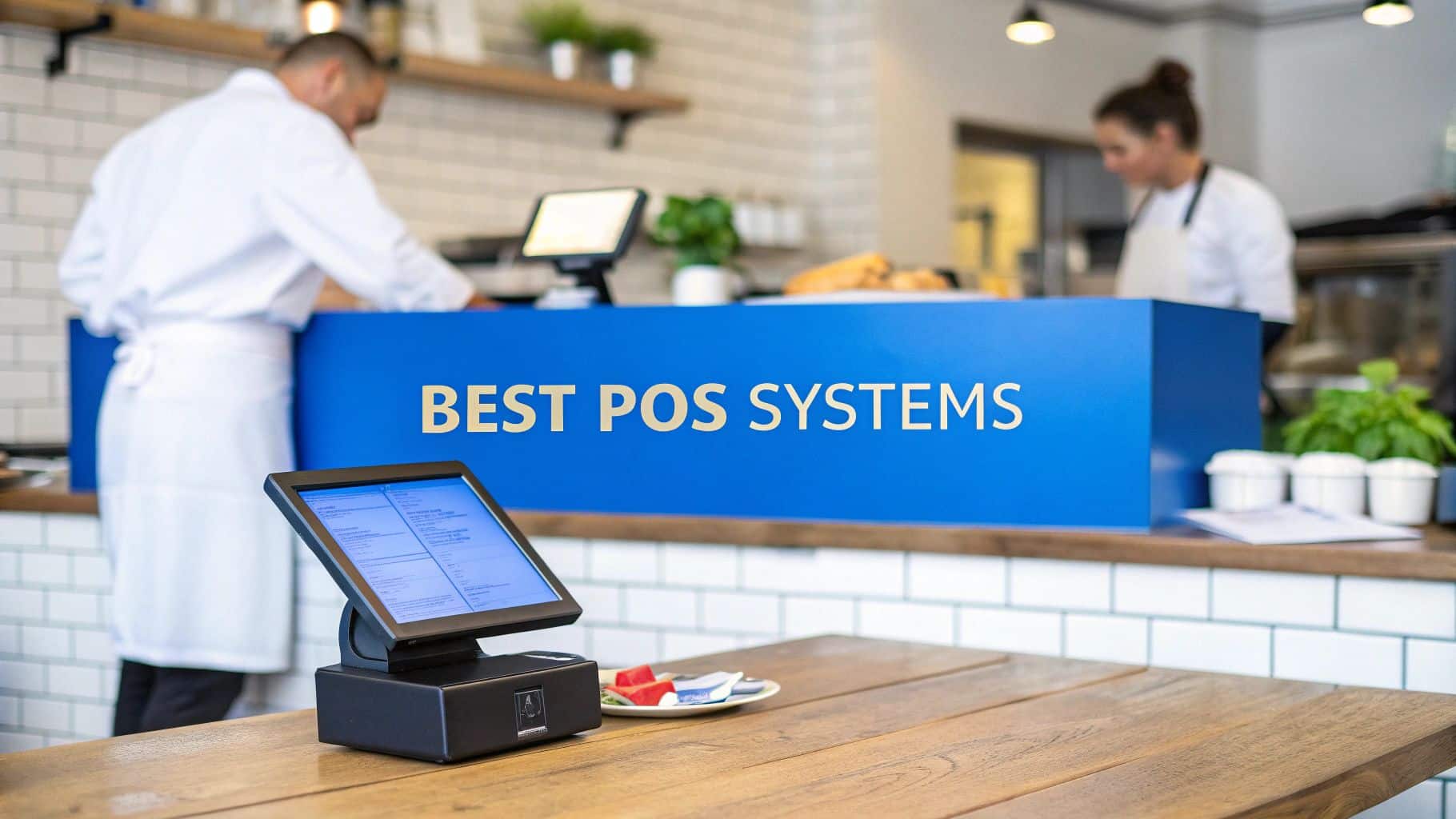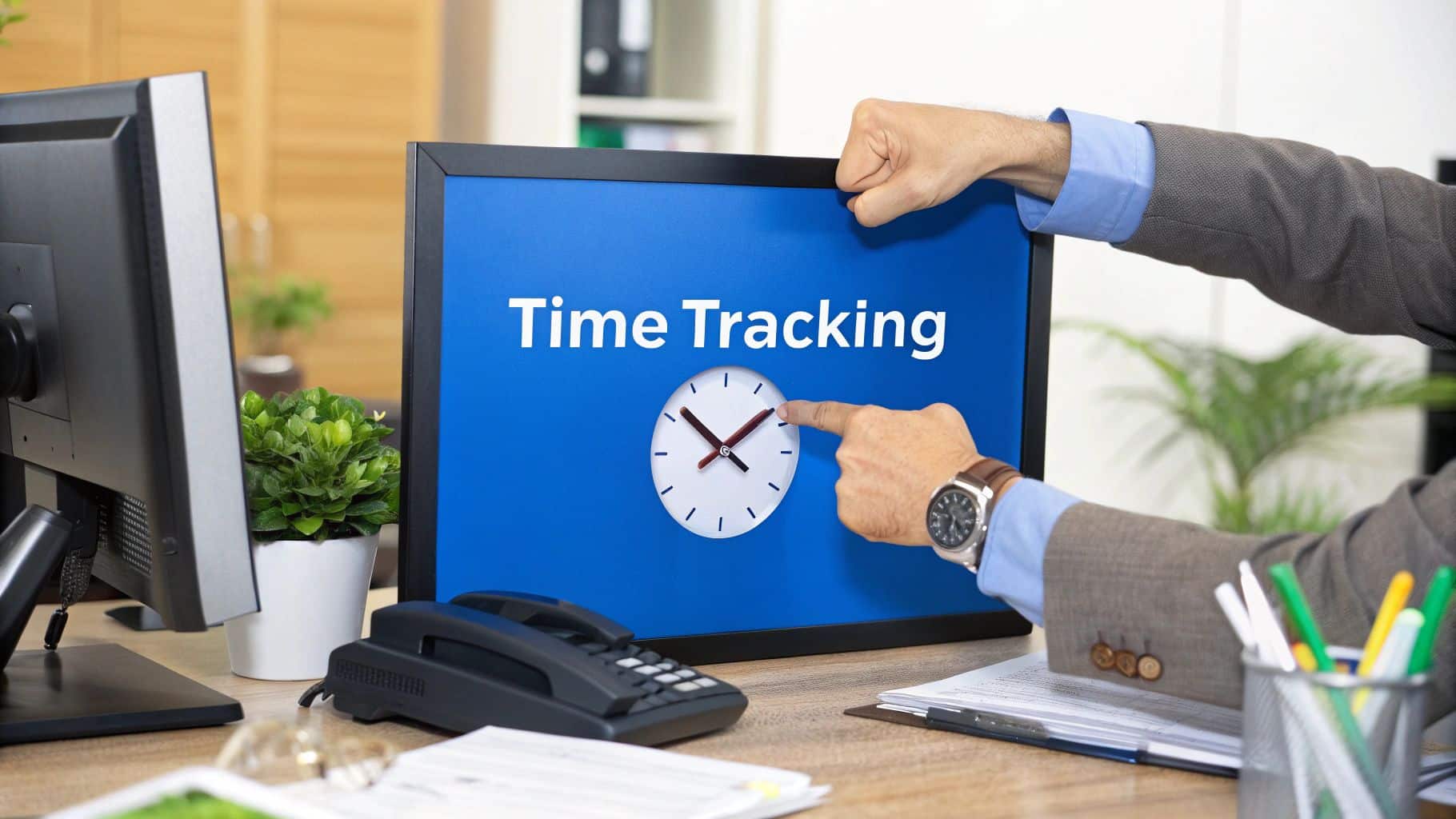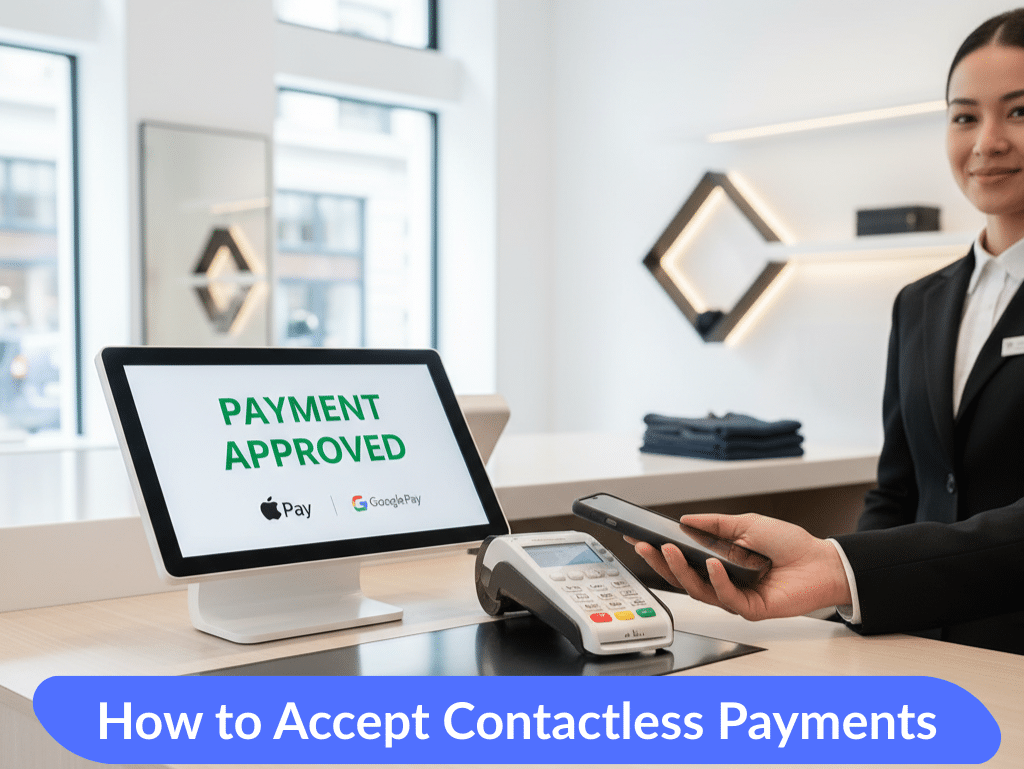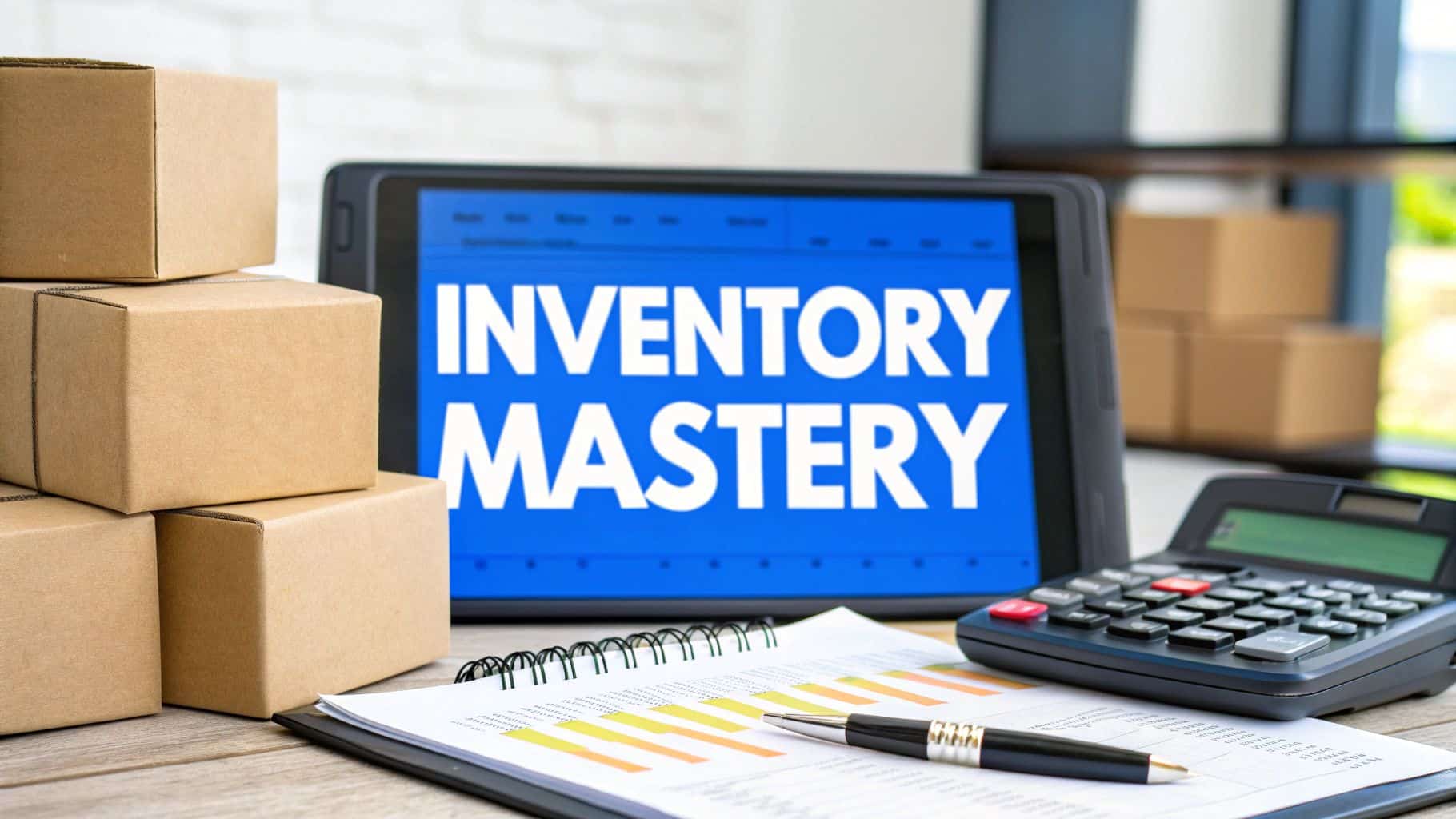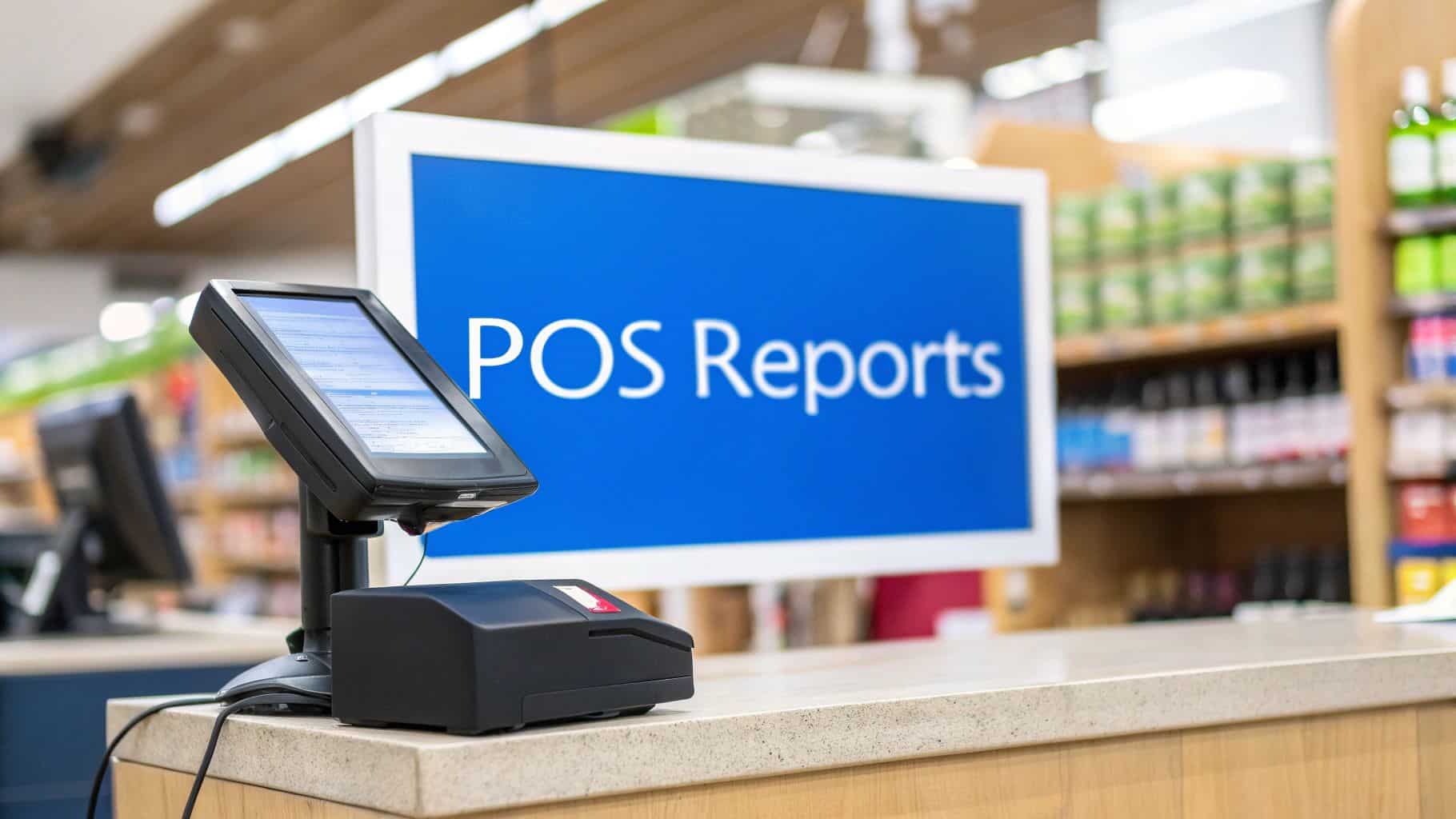Picking the best POS system for your small restaurant means finding that sweet spot between cost, features, and how easy it is to actually use. When you start looking, you’ll see names like Toast, Square, and Lightspeed pop up again and again—and for good reason. They're at the top of the game.
But here's the thing: a POS system isn't just a fancy cash register. It's the command center for your entire operation.
Why Your POS Choice Matters So Much
Making the right choice on your Point of Sale (POS) system is probably the biggest tech decision you'll make for your restaurant. A solid POS makes everything smoother, from punching in orders and taking payments to keeping an eye on your inventory and knowing who your regulars are. It’s the hub that connects every part of your business, and it has a direct line to your efficiency, your customers' happiness, and your bottom line.
This guide cuts through the sales pitches to give you a real, hands-on comparison of the best POS systems for small restaurants. We're going to break down the top players based on how they actually perform in the real world. That way, you can find the perfect fit, whether you're running a busy cafe, a nimble food truck, or a full-service bistro.
What's Driving the POS Market?
It's no secret that restaurant tech is booming. The global market for restaurant POS systems is expected to jump from around USD 1.54 billion in 2025 to USD 2.52 billion by 2034.
What's behind that growth? It's all about how customer habits are changing. Think about it: 63% of restaurants have adopted digital ordering, 57% have integrated mobile payments, and 49% now offer contactless options. You can read more about these restaurant POS market trends if you want to dive deeper.
This isn't just a passing fad. It shows just how important it is to pick a system that works for you today and can keep up with whatever comes next.
A Quick Look at the Top Contenders
To get us started, here’s a bird's-eye view of the systems we’ll be digging into. Each one brings something different to the table, tailored for specific kinds of small restaurant operations.
| Feature | Toast | Square for Restaurants | Lightspeed Restaurant |
|---|---|---|---|
| Ideal For | All restaurant types, from QSR to full-service | Cafes, food trucks, and small restaurants | Bistros and bars with complex inventory |
| Pricing Model | Tiered subscriptions, free starter plan | Free plan available, flat-rate processing | Monthly subscription-based |
| Key Strength | Restaurant-specific hardware and features | Ease of use and transparent pricing | Advanced analytics and inventory control |
| Hardware | Proprietary, industry-grade terminals | Flexible iPad and proprietary options | iPad-based, versatile setup |
We’re going to focus on what really matters: how simple they are to use day-to-day, what hidden costs might be lurking, and which features will actually make a difference to your profits. My goal is to help you find a system that doesn't just work, but helps your business grow.
What to Look For: The Must-Have Features in a Restaurant POS
Before you can pick the right POS, you have to know what separates a basic cash register from a true command center for your restaurant. It’s easy to get lost in sales pitches, but focusing on the core features that solve real-world problems will lead you to the right choice. A great POS should make your life easier, not more complicated.
We can break these essential features down into three buckets: what happens out front with the customer, what happens in the back to keep the business running, and the tools that help you grow. Each piece is critical for running a tight ship, keeping costs down, and making guests happy.
Core Front-of-House Operations
Your front-of-house features are all about the customer experience. This is where speed and accuracy directly impact your reputation and your bottom line. These are the tools your team uses constantly, so they have to be rock-solid.
A clean, intuitive order screen is non-negotiable. During a chaotic dinner rush, your servers need to fire off orders, add modifications ("no onions, extra sauce"), and get it right without a second thought. For places that thrive on customization, like a fast-casual spot, a system with an easy-to-use touchscreen for menu changes is an absolute game-changer.
Payment processing has to be seamless. In today's world, that means accepting everything from credit cards and cash to Apple Pay and Google Pay without a hitch. The little things matter immensely—like easily splitting a check for a large party, keeping a tab open at the bar, or even processing a payment if the internet temporarily goes down.
A POS that constantly freezes or has a confusing payment screen creates a bottleneck right at the finish line. It's frustrating for staff and leaves a bad last impression on your guests. Fast, reliable payment processing isn't a luxury; it's a fundamental part of good service.
And don't forget table management. A visual map of your dining room lets your host see at a glance which tables are open, occupied, or being bussed. This simple tool is incredibly effective for seating guests faster and maximizing every turn.
Back-of-House Management Essentials
While the front-of-house is the show, the back-of-house is where you protect your profit margins. These features give you the data and controls needed to manage your inventory, staff, and overall business health.
Real-time inventory tracking is arguably the most impactful BOH feature. A good system will automatically deduct ingredients from your stock every time you sell a dish, so you always know what you have. The best systems go even further:
- Low-Stock Alerts: You get a heads-up when you're running low on a key ingredient, preventing the dreaded "86" on a popular item.
- Recipe Costing: This lets you calculate the exact cost of every plate that leaves your kitchen, ensuring your menu prices are actually profitable.
- Purchase Ordering: Some systems even help you generate and send POs to suppliers directly from the POS dashboard.
Integrated employee management is another must-have. You need to be able to build schedules, let staff clock in and out, and set permissions so only a manager can apply a discount or void a check. It keeps everyone honest and your operations organized.
Customer Engagement and Growth Tools
The best POS systems do more than just process transactions; they help you build a loyal following. These features turn your sales data into a real marketing advantage.
Customer Relationship Management (CRM) and loyalty programs are your best friends for turning a one-time visitor into a regular. A POS with a built-in CRM can track how often a customer visits and what they like to order, giving you the chance to offer a more personal experience. These tools are central to building powerful customer retention strategies that keep people coming back.
Finally, gift card management opens up another revenue stream and acts as a fantastic marketing tool. Having a system that can issue, track, and redeem both physical and digital gift cards makes the whole process simple for you and your customers.
Comparing The Top Restaurant POS Systems
Picking a POS system from the big names in the industry means looking past the flashy feature lists. What works for a high-volume cafe will likely stumble in a full-service dining room with complex table maps. This comparison gets into the nitty-gritty, focusing on the real-world differences between Toast, Square for Restaurants, and Lightspeed Restaurant from the perspective of a small restaurant owner.
We're going to evaluate what actually matters when you're in the weeds of a busy service. We'll look at the user interface, how tough the hardware is, how easily each system plays with essential apps for delivery or accounting, and whether it can grow with you. This side-by-side look will help you picture which platform truly fits your day-to-day operations, making it easier to choose one of the best POS systems for small restaurants.
Toast: The All-In-One Restaurant Specialist
Toast has carved out a huge slice of the market by building its entire world—software and hardware—just for restaurants. This single-minded focus is its biggest advantage, offering a depth of specialization that more general systems can't quite replicate.
The interface on a Toast terminal is designed for pure speed in chaotic environments. Everything feels intentional, from handheld devices that let servers fire orders from the table to kitchen display systems (KDS) that keep the front and back of the house in sync. For a small but constantly packed bistro, this translates to fewer mistakes and faster table turns.
But here’s the trade-off: this finely tuned ecosystem demands a commitment. Toast requires you to use their proprietary hardware. It's tough, industry-grade stuff, but it locks you into their platform. You can't just download their app onto an iPad you already own. While this ensures everything works seamlessly, it can also mean a higher upfront investment and less freedom if you ever want to switch.
Key Differentiator: Toast’s strength is its complete, end-to-end design built specifically for the chaos of food service. Its integrated hardware and software are made to handle everything from intricate menu modifiers to tracking inventory down to the last onion.
For a new owner who wants a single, comprehensive solution to manage ordering, payments, payroll, and marketing right out of the box, Toast offers a very compelling, unified package. The free starter plan is a great entry point, but keep an eye on costs—they can add up as you tack on more features and terminals.
Square for Restaurants: Flexibility and Ease of Use
Square for Restaurants has become a go-to for cafes, food trucks, and smaller spots by being incredibly easy to use and flexible. Its biggest departure from Toast is that it lets you run its software on standard iPads, which gives you immediate control over your initial hardware spending.
The platform’s dashboard is clean and intuitive, making it a breeze for almost anyone to learn. Getting new hires up to speed is fast, which is a huge plus for places like coffee shops or quick-service counters where you might have higher turnover and can't afford long training periods.
Square's free plan is a massive draw, covering all the core POS functions without a monthly subscription fee. That alone makes it one of the best POS systems for small restaurants running on a shoestring budget. Plus, its transparent, flat-rate payment processing takes the mystery out of transaction fees. To see how different systems stack up, explore our top POS system comparison for 2025.
While Square is super accessible, its restaurant-specific tools aren't as deep as what Toast offers. For example, its inventory management is great for tracking items like bottled drinks or bags of coffee, but it might not have the ingredient-level precision a full-service kitchen needs for a complex, scratch-made menu. Square's magic is in its balance—it's powerful without being intimidating.
This image shows just how sleek and unobtrusive a modern POS can be, proving that powerful tools don't need to dominate your counter space.
Lightspeed Restaurant: Advanced Analytics and Inventory Control
Lightspeed Restaurant finds its sweet spot with more complex small restaurants—think bars with extensive liquor collections, wineries, or fine-dining spots. Its main event is its incredibly powerful analytics and super-detailed inventory management.
If you're an owner who loves to dig into data, Lightspeed is your playground. It lets you track ingredient costs down to the penny, manage all your vendor relationships, and pull detailed reports that show exactly which menu items are your true money-makers. A cocktail bar, for instance, could use Lightspeed to track every ounce of liquor poured, giving them ironclad control over their most expensive inventory.
The system runs on iPads, giving you the same hardware flexibility as Square, but the software itself is built for a more seasoned operator. The interface is highly customizable, so you can mold workflows to fit your exact service style, whether you're running a multi-course tasting menu or a fast-paced bar.
All that power comes with a steeper learning curve and a higher price tag than Square's free offering. Lightspeed is a subscription-based model, and its most impressive features are tucked away in the higher-tier plans. It’s really a system built for growth, perfect for an owner who either needs those sophisticated tools from day one or plans to scale up quickly.
Looking at the broader market, the POS space is dominated by a few key players. In the U.S. restaurant scene, NCR/ALOHA POS holds a 30.18% market share among multi-unit brands, with Oracle/MICROS at 15.60%. In fact, the top 10 POS providers account for a staggering 84.24% of all installations in major metro areas, which just goes to show how established these systems are.
At-a-Glance Comparison of Leading POS Systems
To simplify your decision, this table breaks down the key differences between our top contenders. It’s a quick-reference guide to see which system aligns best with your specific restaurant type, budget, and operational priorities.
| Criteria | Toast | Square for Restaurants | Lightspeed Restaurant |
|---|---|---|---|
| Best For | All-in-one solution for any restaurant type, especially full-service. | Quick-service, cafes, food trucks, and budget-conscious startups. | Bars, fine dining, and restaurants with complex inventory needs. |
| Hardware | Proprietary, industry-grade hardware required. | Works on standard iPads, offering flexibility. | Works on standard iPads, offering flexibility. |
| Pricing Model | Free starter plan; tiered subscriptions for advanced features. | Free core plan; flat-rate payment processing. | Tiered subscription model; no free plan. |
| Key Strength | Fully integrated, restaurant-specific ecosystem. | Unbeatable ease of use and low startup cost. | Powerful inventory management and advanced analytics. |
| Learning Curve | Moderate; comprehensive system takes time to master. | Low; very intuitive and easy to train staff on. | High; advanced features require a learning investment. |
Choosing the right system comes down to your specific needs today and your plans for tomorrow. Each of these platforms is a leader for a reason, but only one will be the perfect fit for your restaurant.
Side-by-Side Comparison: Making The Right Choice
Let's put these systems into real-world situations to see where they really stand out. Matching the right tool to the right job is everything.
Imagine a quick-service taco shop where speed is king. Square for Restaurants is the clear winner here. Its simple interface lets cashiers fly through orders, and being able to use iPads keeps those initial costs down.
Now, picture a full-service Italian bistro with an extensive wine list. This is where Lightspeed Restaurant would be the better choice. Its advanced inventory tools can easily manage the complexities of a wine cellar, while its deep sales analytics can tell the owner precisely which pasta dishes are bringing in the most profit.
Finally, think of a brand-new restaurant owner who wants a single, do-it-all system. Toast is often the answer. The complete package—durable hardware, integrated payroll, and built-in online ordering—provides a ready-made operational toolkit from one company, which dramatically simplifies management from day one.
Calculating the True Cost of a POS System
When you're searching for the best POS system for your small restaurant, that shiny monthly subscription fee is just the tip of the iceberg. To avoid sticker shock down the road, you have to look at the total cost of ownership. This includes a few layers of expenses that can really sneak up on you if you’re not prepared.
Let’s start with the most obvious one: the upfront hardware costs. Some modern POS systems run on an iPad you might already have, but many require you to buy their specific terminals, kitchen display systems (KDS), printers, and cash drawers. This initial investment can easily range from a few hundred bucks to several thousand dollars, especially if you need more than one station.
Unpacking Software and Subscription Fees
Once the hardware is in place, your next recurring expense is the software subscription. Most POS companies use a tiered pricing model. The free or entry-level plan might cover the basics, but the tools you really need to grow—like solid inventory tracking or a customer loyalty program—are almost always locked away in the more expensive tiers.
This is where you need to think ahead. A free plan looks great on day one, but if you know you'll need to upgrade in six months to get essential features, you might find that a more inclusive plan from a competitor was actually the more affordable choice from the start.
So many owners get fixated on the monthly software fee. The real story is often buried in payment processing rates and all the little add-ons. A system that looks cheap at first can quickly become a major expense if you don't read the fine print.
The Inescapable Cost of Payment Processing
Every single time a customer pays with a card, you're paying a payment processing fee. It's usually a small percentage of the sale plus a few cents (a common rate is 2.6% + $0.10). While that doesn't sound like much per transaction, it adds up to a massive operating cost over thousands of orders.
Some POS providers lock you into their own in-house payment processor, which doesn't always give you the best rates. Others let you bring your own processor, but might hit you with an extra monthly fee for doing so. For a much deeper dive, our guide on understanding restaurant POS system costs breaks all of this down.
Overlooked and Hidden Expenses
Finally, you have to budget for the costs that aren't advertised in big, bold letters. These are the expenses that can blow your budget if you're not looking for them.
- Setup and Installation: Need a professional to come in and get everything wired up? That’s often a one-time fee.
- Training Fees: While some basic guides are free, dedicated training sessions to get your staff comfortable with the new system can cost extra.
- Premium Support: Basic email support is one thing, but 24/7 phone support—which is non-negotiable when your system goes down during a dinner rush—is frequently a paid upgrade.
- Add-On Modules: Want to add online ordering, advanced marketing tools, or payroll integrations? Expect to pay an extra monthly fee for each one.
When you add it all up—hardware, the right software tier, realistic payment processing fees, and any necessary add-ons—you get a much clearer financial picture. This is how you find a POS that not only has the right features but also fits comfortably within your restaurant's actual budget.
Getting Set Up: POS Implementation and Support
Picking the right POS software is a huge step, but it’s really only half the battle. A smooth rollout is what actually turns that promising new system into a tool that helps your restaurant run better. The best POS systems for small restaurants aren't just plug-and-play; their implementation is a carefully managed process designed to get your team up and running without missing a beat.
A good launch plan starts well before any hardware shows up at your door. It begins with data migration—the process of moving your existing menus, ingredient lists, and customer data into the new system. A quality POS provider will have tools or even a dedicated team to help with this, saving you from the soul-crushing and error-prone task of re-entering everything by hand.
After the data is squared away, it’s time for the physical hardware setup. This means installing the terminals, kitchen display systems (KDS), printers, and card readers. While some modern systems are simple enough to set up yourself, many providers offer professional installation. This is often worth it just to avoid technical headaches during a busy dinner service.
Staff Training Is Everything
The most important part of any implementation is staff training. If your team isn't comfortable with the new system before you go live, you’re in for a world of hurt. The leading POS companies get this, and they typically offer a mix of training resources to suit different schedules and learning preferences.
Look for a provider that offers a combination of:
- Live Onboarding Sessions: These are guided walkthroughs with a specialist who can answer questions about your restaurant's specific workflow.
- On-Demand Video Tutorials: Short, targeted videos are perfect for when a server needs a quick refresher on how to split a check or apply a complex discount.
- Comprehensive Knowledge Bases: Think of this as a searchable online encyclopedia for your POS, filled with detailed articles and step-by-step guides for troubleshooting.
When your staff feels confident, the POS becomes a natural extension of their work, which directly boosts order accuracy and speed. This is more important than ever.
In the U.S., a staggering 72% of restaurants are now using mobile POS devices to improve service, and small businesses are adopting POS systems at a 25% annual growth rate. You can discover more point-of-sale statistics that paint a clear picture of just how central this technology has become.
Why Great Customer Support Is Non-Negotiable
Once you're up and running, your relationship with the POS company shifts from implementation to ongoing support. For a small restaurant, downtime is a killer. A frozen screen or a payment glitch during a Friday night rush can cost you money and damage your reputation.
This is where you learn the true value of customer support. A cheap POS with slow, unhelpful support isn't a bargain—it's a liability. You’re not just buying a product; you’re choosing a long-term partner whose reliability directly impacts your own.
When you’re weighing your options, look beyond a basic email ticketing system. The best providers offer multiple ways to get help. 24/7 phone support is the gold standard, as it gives you immediate access to a real person who can talk you through a problem, day or night. Live chat is great for quick questions, and some plans even include a dedicated account manager for more personalized help.
Before you sign anything, ask vendors about their average response times and dig into user reviews that specifically talk about their support experience. Doing this homework upfront ensures you’ll have a lifeline you can count on when you need it most.
So, How Do You Make the Final Call?
Alright, you've seen the comparisons, and now it's time to pick a winner for your restaurant. The best POS system isn't about having the most features; it's about having the right features for how you actually run your business. Think of it less as a purchase and more like hiring a key employee—it needs to fit your workflow, your budget, and where you want to go in the future.
If you’re running a food truck, a coffee cart, or just starting out with a pop-up, your priorities are probably speed and keeping startup costs low. This is where a system like Square for Restaurants really shines. You can get started with their free plan and a basic iPad, making it one of the most approachable options out there.
Matching the System to Your Style
On the other hand, if you're running a full-service restaurant that's starting to get busy, you're dealing with a different set of problems. You need granular control over your inventory and a way to make sense of your sales data. That's the sweet spot for a system like Lightspeed Restaurant. It's built for complexity and gives you the kind of deep analytics that help you make smarter business decisions, which easily justifies the monthly fee.
Then there are the owners who just want one system to rule them all. If you prefer a single, tightly integrated platform that handles everything from online orders to payroll without any fuss, Toast is hard to beat. Their whole model is built around providing a seamless, all-in-one ecosystem with their own hardware, which is perfect if you don't want to mess with third-party integrations.
Remember, a POS system is an investment in your restaurant's future, not just another monthly bill. The right one simplifies your life today and gives you the tools you need to expand tomorrow.
Before you commit to a multi-year contract, it's time to get some straight answers from the vendors. Don't be shy—ask the tough questions now to avoid headaches later.
Key Questions to Ask Any POS Vendor
- What exactly am I paying for? I need a full breakdown of every single fee—monthly software costs, payment processing rates, hardware, and any hidden charges.
- Can you walk me through a live demo of the back-office dashboard? I want to see the reporting and inventory tools in action.
- What happens when things go wrong at 8 PM on a Friday? What kind of support is included, and what are your real-world response times?
- As my business grows, what’s the process for adding another terminal or upgrading my plan? What are the costs?
- Let's talk about the fine print. Are there contract-breaking fees? Do I own the hardware outright or am I just leasing it?
Your Top Restaurant POS Questions, Answered
Picking the right POS system for your small restaurant is a big decision, and it's normal to have a few questions left over. Let's tackle some of the most common ones we hear from owners who are in the final stages of making their choice.
Can I Just Use an iPad for My Restaurant POS?
You bet. In fact, some of the best POS systems out there are built specifically to run on iPads. This is a huge win for small restaurants because it keeps your initial hardware costs way down compared to buying clunky, proprietary terminals.
Systems like Square and Lightspeed have fantastic iOS apps that transform a regular iPad into the brain of your entire operation. The key is to make sure you get the right gear to go with it—like compatible receipt printers, cash drawers, and card readers that are guaranteed to play nice with your software.
What’s the Difference Between a POS and a Simple Card Reader?
This one trips a lot of people up, but the distinction is crucial. A card reader does one thing: it takes payments. A true POS system is the software that runs your entire business, and payment processing is just one piece of that puzzle.
Think of it this way: the card reader is just the tool, but the POS system is the entire toolbox. Your POS is mission control for everything from taking orders and tracking inventory in real-time to running sales reports, managing staff schedules, and building customer loyalty programs. It’s the engine that powers your restaurant.
Are Integrations Really That Important for a Small Restaurant?
For a small spot, they’re not just important—they’re essential for staying sane and profitable. Integrations are the digital handshakes that connect your POS to the other software you rely on, saving you from the nightmare of manual data entry.
The right integrations turn your POS from a simple cash register into the true command center of your business. They make sure data flows where it needs to, automatically and accurately, giving you a clear picture of your restaurant’s health without the grunt work.
Here are a few integrations that can make a massive difference:
- Accounting Software: Automatically syncing sales data with programs like QuickBooks.
- Online Ordering & Delivery: Pulling orders from third-party apps directly into your kitchen.
- Payroll Services: Simplifying how you track hours and pay your team.
A POS with a solid library of integrations will save you an incredible amount of time, cut down on costly mistakes, and give you a single, reliable view of how your business is actually doing.
Ready to see how a truly integrated and intuitive system can transform your operations? Biyo POS offers an all-in-one solution designed for the unique demands of small restaurants, combining powerful features with unparalleled ease of use. Explore Biyo POS and start your free trial today.
